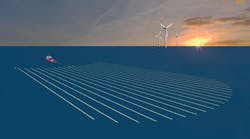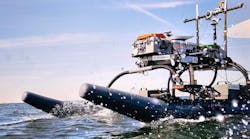The Campos Basin is the most prolific hydrocarbon-producing basin in Brazil, accounting for nearly 70% of Brazil's production annually. Since the first discovery offshore in 1974, over 11 billion boe have been discovered in the Campos Basin.
Exploration currently is focused on targets in ultradeep water (>1000 meters), and recent discoveries have been made in water depths approaching 2000 meters. The purpose of this study was to assess the undiscovered oil and gas potential of the Campos, including the hydrocarbon potential in ultra-deepwater.
The Campos Basin is a classic rift-drift basin that formed when the African plate separated from the South American plate in the Early Cretaceous (Ojeda, 1982). The resulting rift phase evolved into a passive margin (drift) phase from the Late Cretaceous through the Tertiary. The petroleum system in the Campos Basin is the result of this rift-drift evolution (Guardado and others, 1990; Mohriak and others, 1990; Cainel* and Mohriak, 1998).
Lagoa Feia formation
Oil-source rock correlations have demonstrated that organic-rich mudstones of the Neocomian Lagoa Feia formation are the source for oils in the Campos Basin (Mello and Maxwell, 1990; Mello and others, 1994). Mudstones of the Lagoa Feia were deposited in lake systems that occupied rift basins following plate separation in the Early Cretaceous.
The mudstones have organic carbon contents with a range of 2-6 weight-percent carbon, and are as high as 9 weight-percent. The Lagoa Feia source rocks reached maturity in parts of the Campos during the Miocene as a result of deposition of several thousand meters of Tertiary clastic sediments. Migration of the Lagoa Feia oil was largely up and along normal faults related to rifting, and along Tertiary growth faults that sole in Aptian salt.
For the purposes of the oil and gas assessment, the Lagoa Feia Petroleum System in the Campos Basin was divided into three areas, or assessment units, based on predominant reservoir type and/or trap type.
- Assessment Unit #1 encompasses the area characterized by Late Cretaceous-Tertiary turbidite reservoirs in structural and stratigraphic traps. Included in this assessment unit are all of the existing fields with turbidite reservoirs from Late Cretaceous through Miocene age, including giant fields such as Marlim, Albacora, and Roncador. The geographic limits are the updip limits of the turbidites to the west, the Cabo Frio Arch to the south, the Vitoria-Trinidade Arch to the north, and the offshore limit was placed at the boundary of the salt diapir region at water depths of approximately 2200 meters.
- Assessment Unit #2 encompasses the shelf area of the Campos Basin, and includes reservoirs associated with rift and immediate post-rift stratigraphic units such as carbonate reservoirs of the Macae Formation, Alagoas conglomerates, Lagoa Feia coquinas, and Lagoa Feia conglomerates. The geographic limits to this assessment unit are the updip pinchout of reservoirs to the west, the Cabo Frio and Vitoria-Trindade arches to the south and north, respectively, and the Cretaceous carbonate shelf edge to the east. Assessment Units #1 and #2 overlap on the shelf area.
- Assessment Unit #3 encompasses the area of salt diapirs and other structures in water depths between about 2,200 meters and 3,800 meters. The assessment unit is hypothetical, with no discoveries to date. Traps are postulated to be the result of salt movement, and reservoirs are postulated to be turbidite sandstones sourced from the west and deposited between salt structures. The source rock may be the Lagoa Feia or may be mudstones of Middle Cretaceous age. However, the assessment of this unit was heavily risked on the presence of adequate source rock.
Probability distribution
Using a combination of published geology (mainly by Petrobras) and analysis of historical production data by field and data from geologic analogs, a probability distribution was developed for sizes and numbers of undiscovered oil and gas accumulations in each assessment unit.
The three assessment units were then assessed using a Monte Carlo approach for conventional oil in oil fields, associated gas in oil fields, NGL in oil fields, gas in gas fields, and NGL in gas fields. An estimate was also made of the potential largest undiscovered oil and gas field in each assessment unit.
For Assessment Unit #1:
- Mean oil in fields is about 11 billion bbl
- Mean associated gas in oil fields is about 4.7 tcf
- Mean NGL in oil fields is about 14 million bbl
- Mean non-associated gas in gas fields is about 3,000 bcf
- Mean NGL in gas fields is about 9 million bbl
- Largest undiscovered oil field is about 1.6 billion bbl of oil
- Largest undiscovered gas field is about 1,000 bcf of gas.
For Assessment Unit #2:
- Mean oil in oil fields is about 1 billion bbl
- Mean associated gas in oil fields is about 1 tcf
- Mean NGL in oil fields is about 4 million bbl
- Mean non-associated gas in gas fields is about 800 bcf
- Mean NGL in gas fields is about 3.5 million bbl
- Largest undiscovered oil field is estimated at about 140 million bbl
- Largest undiscovered gas field is estimated at about 260 bcf.
For Assessment Unit #3:
- Mean oil in oil fields is about 5.6 billion bbl
- Mean associated gas in oil fields is about 3.6 tcf
- Mean NGL in oil fields is about 15 million bbl
- Mean non-associated gas in gas fields is about 1.5 tcf
- Mean NGL in gas fields is about 6 million bbl
- Largest undiscovered oil field is about 1.25 billion bbl of oil
- Largest undiscovered gas field is about 620 bcf.
The mean estimates for Assessment Unit #3 are heavily risked on the presence of adequate source rock.
A complete list of references is available from the author.
Author
Christopher J. Schenk is a geologist with the U.S. Geological Survey in Denver, Colorado. For the past 20 years, he has focused on the assessment of oil and gas resources, mainly in the U.S. Gulf Coast, Alaska, and South America. He is currently oil and gas assessment coordinator for the U.S. and for Central and South America.




